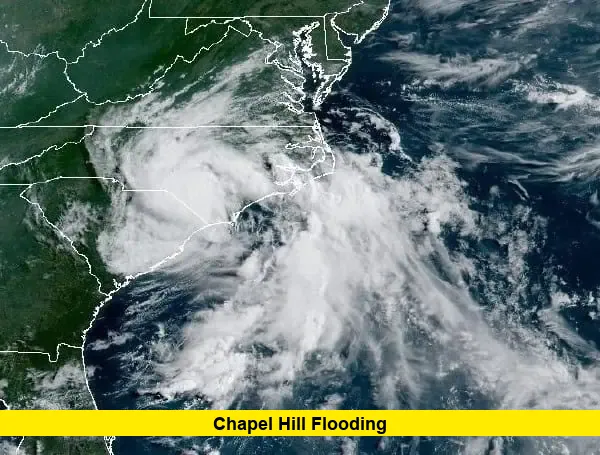Heavy rainfall unleashed by Tropical Depression Chantal has triggered significant flooding in Chapel Hill and across central North Carolina. As of Monday morning, July 7, 2025, local authorities and emergency services remain on high alert, responding to rising waters, road closures, and urgent rescue operations. This article delivers the most up-to-date, verified news on the unfolding Chapel Hill flooding, with a focus on the latest impacts, community response, and what residents need to know next.
Chapel Hill Flooding: Real-Time Impact of Chantal
Torrential downpours began late Sunday as the remnants of Chantal swept through the region. By early Monday, several neighborhoods in Chapel Hill were grappling with flash flooding. Local officials reported that rainfall totals ranged from 2 to 4 inches, with isolated areas seeing up to 6 inches in just a few hours. This rapid accumulation overwhelmed drainage systems and caused water to surge onto roadways and into low-lying communities.
Key intersections, including Raleigh Road at Fordham Boulevard, became impassable overnight. Emergency crews responded to multiple calls for stranded vehicles and water rescues. In one instance, a driver was pulled to safety after their car became submerged near a flooded shopping center. Chapel Hill authorities have issued repeated warnings: never attempt to drive, bike, or walk through floodwaters, as even shallow water can be life-threatening.
Key Point Summary
- Chapel Hill flooding escalated overnight due to heavy rain from Tropical Depression Chantal.
- Multiple roads and neighborhoods are affected, with water rescues reported.
- Rainfall totals reached up to 6 inches in some areas.
- Power outages and infrastructure damage have occurred.
- Flood Watches remain in effect through Monday.
- Authorities urge residents to avoid flooded areas and monitor official updates.
Emergency Response and Community Safety
The Town of Chapel Hill activated its emergency response protocols as flooding intensified. Firefighters, police, and public works teams worked through the night to close hazardous roads, assist with evacuations, and clear debris. The Camelot Village apartment complex was among the hardest hit, with several units evacuated due to rapidly rising waters. Temporary shelters have been set up for displaced residents.
Duke Energy reported nearly 6,000 customers without power in the Triangle region, including parts of Chapel Hill. Repair crews are working to restore service as quickly as conditions allow. Local hospitals and emergency rooms remain open, but officials advise seeking care only for urgent needs to keep resources available for flood-related emergencies.
Flooding Hotspots in Chapel Hill
| Location | Status | Notes |
|---|---|---|
| Raleigh Rd at Fordham Blvd | Closed | Major flooding, avoid area |
| Camelot Village Apartments | Evacuated | Residents relocated for safety |
| W. Franklin St (100 block) | Closed | Water over roadway |
| Hillsborough St (MLK to Bolinwood) | Closed | Flooding, crews on site |
Chapel Hill Flooding: Weather Outlook and Ongoing Risks
Although Chantal has weakened to a tropical depression, the risk of additional flash flooding remains high through Monday. The National Weather Service has extended Flood Watches for central North Carolina, including Chapel Hill. Forecasters warn that saturated ground and ongoing showers could lead to further rises in creeks and rivers, especially in urban and low-lying areas.
Residents should expect spotty showers throughout Monday, with the possibility of stray storms into Tuesday. High humidity and temperatures in the low 90s will add to the discomfort for those dealing with flood cleanup. The middle of the week is expected to bring more afternoon and evening storms, potentially prolonging hazardous conditions.
What Residents Should Do
- Stay informed: Monitor local news and official town updates for the latest on road closures and evacuation orders.
- Avoid floodwaters: Do not attempt to cross flooded roads or walkways.
- Prepare for outages: Keep flashlights, batteries, and emergency supplies on hand.
- Check on neighbors: Especially those who are elderly or have limited mobility.
Chapel Hill Flooding: Community Response and Resilience
Despite the challenges, Chapel Hill residents are coming together to support each other. Volunteers have helped distribute sandbags, deliver meals to those in need, and assist with cleanup efforts. Local businesses have offered shelter and supplies to those displaced by the flooding.
The city’s emergency management team continues to coordinate with state and federal agencies to ensure resources are available for recovery and rebuilding. Officials stress that while the immediate threat may subside as Chantal moves northeast, the risk of flash flooding is not over. Community members are urged to remain vigilant and follow all safety guidance.
Flooding and Climate Trends in Chapel Hill
Recent studies from UNC-Chapel Hill and NC State highlight that flooding in the region is becoming more frequent and severe, not only during tropical storms but also after heavy rain events. Experts warn that as climate patterns shift, Chapel Hill and similar communities must adapt with improved drainage, infrastructure, and emergency planning.
Conclusion
The Chapel Hill flooding crisis triggered by Tropical Depression Chantal is a stark reminder of the region’s vulnerability to extreme weather. As emergency crews continue their tireless work and neighbors help each other recover, the community’s resilience shines through. Stay alert, stay safe, and look out for one another as Chapel Hill navigates the aftermath of this historic flooding event.
